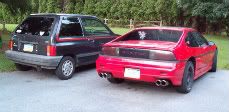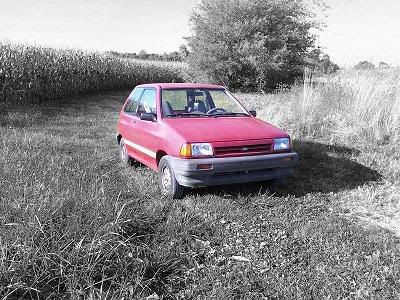I'm standing at a crossroads, and am seeking advice...
About 4 years ago, I picked up a parts car, cheap. It was banged-up, rusted, and the seller knew nothing about it (he was operating a shade-tree salvage yard). No title, no radiator, no steering column, no speedo, and absolutely no idea why this poor thing was put out to pasture.
I brought it home, and stashed it out in my back acreage...right next to another parts car. I did not even really go through the thing, and see what was good or bad.
Fast-forward to this last week. I decided to scrap this poor thing out. removed every usable nut, bolt, harness, etc. pulled the engine/tranny (5speed), and set it aside. Cut-up the chassis, and added the pieces to the scrap metal pile. After all the dust had settled, and the parts were all put away, I decided to see if the engine had any promise. Amazingly, it still turned, freely!
Pulled the plugs, and did a quick, crude compression test. #1: 195psi, #2: 185psi, #3: 180psi, and #4 190psi. Unbelievable! This engine, had been sitting for years, and (to me) those numbers are staggering, considering the storage conditions and time.
Decided that I would tear it down, and go through the whole block and head, with intentions of honing the cylinders and maybe a simple valve grind. Fresh seals and gaskets all around.
Yesterday, I removed the cylinder head. Pistons were really clean. But what I saw next has me stumped...
The cylinder walls still have cross-hatch marks! Not fresh marks, but still visible, if you look close enough. From what I can tell, this engine is all-original, and has not been touched.
The advice I seek is this: Should I continue tearing this motor down, and honing the cylinders, or just leave the block alone?
Like I said, standing at a crossroads. I just wish I knew more about the history of this car and motor...
Any advice is appreciated.
Thanks in Advance!
Scott
About 4 years ago, I picked up a parts car, cheap. It was banged-up, rusted, and the seller knew nothing about it (he was operating a shade-tree salvage yard). No title, no radiator, no steering column, no speedo, and absolutely no idea why this poor thing was put out to pasture.
I brought it home, and stashed it out in my back acreage...right next to another parts car. I did not even really go through the thing, and see what was good or bad.
Fast-forward to this last week. I decided to scrap this poor thing out. removed every usable nut, bolt, harness, etc. pulled the engine/tranny (5speed), and set it aside. Cut-up the chassis, and added the pieces to the scrap metal pile. After all the dust had settled, and the parts were all put away, I decided to see if the engine had any promise. Amazingly, it still turned, freely!
Pulled the plugs, and did a quick, crude compression test. #1: 195psi, #2: 185psi, #3: 180psi, and #4 190psi. Unbelievable! This engine, had been sitting for years, and (to me) those numbers are staggering, considering the storage conditions and time.
Decided that I would tear it down, and go through the whole block and head, with intentions of honing the cylinders and maybe a simple valve grind. Fresh seals and gaskets all around.
Yesterday, I removed the cylinder head. Pistons were really clean. But what I saw next has me stumped...
The cylinder walls still have cross-hatch marks! Not fresh marks, but still visible, if you look close enough. From what I can tell, this engine is all-original, and has not been touched.
The advice I seek is this: Should I continue tearing this motor down, and honing the cylinders, or just leave the block alone?
Like I said, standing at a crossroads. I just wish I knew more about the history of this car and motor...
Any advice is appreciated.
Thanks in Advance!
Scott



Comment